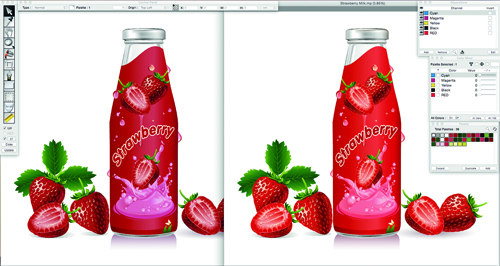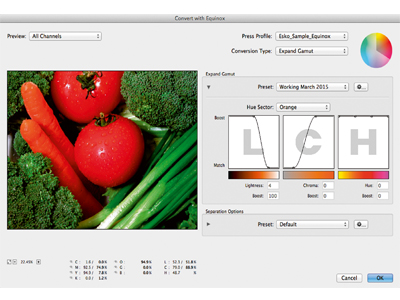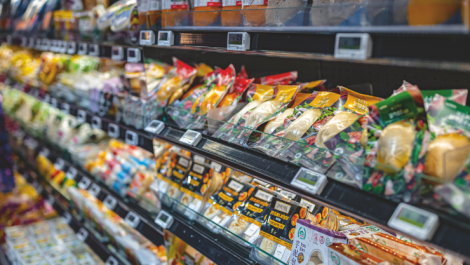Esko has developed an Equinox Photoshop plug-in that converts CMYK (or RGB) images into expanded gamut
Printing with expanded colour gamuts by using a fixes ink set promises considerable cost savings providing you get the process control right. By Nessan Cleary.
One of the defining characteristics of flexo printing is the widespread use of spot colours, which delivers strong, vibrant colours, but pushes up the costs. The alternative is to use a fixed ink set with an extended colour gamut. The basic concept is that adding additional colours, typically orange, green and blue or violet to the CMYK ink set should expand the gamut enough to do away with the need for separate spot colours, while still delivering strong images.
Steve Donegan, managing director of Graphic Republik, explained, ‘If you can get a press to print with a fixed set of colours where you can cover a high percentage of spot colours and they are acceptable to the client, then the benefits to the printer and the cost savings to the customer are massive.’
The main saving is because there are no additional makereadies from having to change the spot colour inks on the press. This saves a considerable amount of time, and a certain amount of consumables. But there is a further advantage as using a fixed colour palette should make it easier to establish good process control and to get consistent colours, because the same ink set is being used all the time. Moreover, it also makes it easier to establish a standardised way of working.
However, although most experts agree that using a seven colour ink set does lead to better results than four colours; those results are still not in the same league as dedicated spot colours. Mr Donegan said, ‘You have to be upfront with the brand owner over how the print will look and the cost savings. Some brand owners are very precious about their colours until you tell them how much they could save.’
Images
For the most part, expanded gamut printing is applied to vector art, as the main priority is to cut down on the cost of the spot colours, which are themselves mainly used in brand logos and artwork. But Mr Donegan argued that images can also benefit, ‘So something like a slice of an orange should look better because you are using orange to make the picture. So it should be about having an enhanced product as well as the cost savings.’
Graphic Republik also sells an interesting alternative, MaxColor, which can produce images with extended colour. This can convert CMYK separations to spot colours. So, for example, a spot red could be used to replace the magenta plate, leading to a more vibrant red without adding an additional colour. It can be manually tweaked and includes an internal monitor calibration system to show the effect of the spot colours on screen. There is also the ability to mask part of an image to maximise the effect of the spot colour.

This example from MaxColor shows an image in CMYK on the left and CYK+red on the right
Conversion
Esko has developed its Equinox system to handle extended colour gamuts. This is a collection of different products and services, which includes software to profile equipment and to convert jobs as well as assistance from Esko’s consultants. It relies on making a profile of the press, complete with the customer’s chosen ink set.
It also includes a tool for optimising the print build. David Harris, product manager for Esko’s colour products, explained, ‘It can be that the accurate build has a small percentage of black or another ink and we can make a better build by zeroing that ink out which reduces the amount of ink in the build and makes the result more stable and leads to higher quality.’
Equinox also includes a tool for converting extended colour gamuts in images, though Mr Harris noted that this is more difficult to do. He explained, ‘With spot colours you can make the conversion very easily but imagery is much more subjective. You might want to make the colours a bit more vibrant but you don’t want to overdo it and make the images look unnatural.’
Esko’s solution is a Photoshop plug-in. Mr Harris explained, ‘This gives you a good gamut amplification with lots of sliders and controls on screen so that you can judge it with confidence because image reproduction is as much about aesthetics.’ He continued, ‘You can do this retouching in the plug-in. You can save the ink transformation as a device link profile which means that you can use that transformation on images in an automated workflow. So if you had a lot of very similar images then you can apply that same transformation to all of them.’
No spots
Kodak also has an option for handling extended colour gamuts. Its Spotless software can convert spot colours to process colours using from four up to seven colours. Essentially it simulates the spot colours as tints of the process colours.
Grant Blewett, global sales director for packaging, said that Kodak’s Flexcel NX system can achieve a much wider colour gamut than other flexo systems, adding, ‘We understand that there is a significant amount of the Pantone Guide that can’t be addressed with four colours, but we have enlarged this space so that we can now ask how much work can be done in a four-colour build.’ He continued, ‘So the software tells you that some parts of the file can be done in four colour and within the delta rating that the printer specifies and which parts can be addressed. If the printer wants, it can go to a six or seven colour process.’
The press has to be fingerprinted and the software then maps the colours to the theoretical colour gamut that press can achieve. Mr Blewett explained, ‘It is a system that will map the colour space and then map the artwork to that colour space. The crux of the matter is process control and if you get that then any system will work.’ It will work with both images and artwork though Mr Blewett said that it is really just an additional element of the Flexcel NX system.
Matching system
Opaltone has taken a slightly different approach, adding red, green and blue to the standard CMYK process colours. It is a simple concept – that these primary colours complement the CMYK colours in a more pleasing way than adding additional colours. It relies on multi-colour ICC profiles and does away with the need for Pantone spot colours, using instead swatch books based on the Opaltone Matching System, which includes some 2982 colours.
At the heart of the system is Opaltone CX software that automatically separates both the artwork and the images – though the images are converted to CMY+RGB. This is because the RGB mix simulates the black so there is no need for a process K in images, but black ink is still needed for text and barcodes. The CX software is a Photoshop plug-in that can separate both CMYK and RGB files.
The inks must be certified by Opaltone and the Hue angle and densities must be calibrated via an OT7 target, which provides density targets throughout the tonal scale. The printer must also pass an OT7 certification before they can sign up to Opaltone’s Technology Access Agreement to be able to use the system.
There is also a VK system suitable for inkjet, which uses CMY+RGB inks, so that proofers can be OT7 calibrated. This comes with its own VK Proofing RIP.
Revolution?
Two years ago a group of suppliers came together to develop the Revo system, which is based around Novue Gidue’s Digital Flexo concept. This involves changing the plates between jobs on the fly, with the press still running. Esko has contributed the pre-press software to the project and its business development manager, Dan Pulling, explained, ‘If you can change your printing plates in three minutes then it slows things down if you have to wash the press. So we ask everyone to have seven colours on the press.’ However, he accepted that converters are still having to use spot colours with some jobs as not all brand owners are willing to switch to a fixed palette.
This touches on the central problem with switching to a fixed palette – the main saving is in the reduced time to change from one job to another so it only applies if the majority of jobs can be printed through a seven colour ink set. Most ink suppliers will offer an extended gamut ink set. However Jonathan Sexton, European marketing manager for Sun Chemical, said that there is a limited take-up in the market, ‘We get requests from time to time and customers do some work with extended colour gamut systems, but it’s not something that we see as really democratised across the market despite the advantages.’
Mr Pulling concedes that the take-up in Europe is relatively low, with only about 55 companies using extended colour gamuts, and very few willing to talk about it. He said that the situation is very different in North America, ‘About 20% of all flexible packaging is being printed in seven colours. A huge number of companies are trying to simplify their packaging and to do a lot more with CMYK.’ Given that the European packaging industry is under the same financial pressures, it seems inevitable that we will see greater use of expanded colour gamuts here.






